If you want to enjoy spring’s loveliest—and most fleeting—display of colorful wildflowers, it’s time to plan a trip to a greenway near you! April and May are peak showtime for a variety of colorful perennials emerging from their winter slumber.
Thanks to the longer days and warming temperatures, little splashes of color will soon appear on the forest floor and along the banks of creeks and streams. Known as “spring ephemerals,” these wildflowers bloom early, linger briefly, and disappear before the trees are leafed out. This dazzling show of spring color is only a limited engagement, so take time to see the flowers before they are gone. No ticket is required to visit a greenway, and you’re guaranteed a front row seat whether you are on foot or bike!
Here are a few of the native wildflowers you can see along the greenways this spring:
|
Bluebells (Mertensia virginica) One of the most stunning early spring wildflowers! Buds are pink, turning to light blue blooms. Plants grow up to two feet tall and are often found in large groups. |
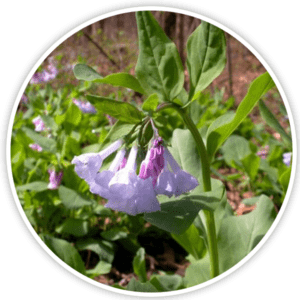 |
|
Dutchman’s Breeches (Dicentra cucullaria) Pink, sometimes white spring wildflower that resembles a series of miniature white knee breeches hanging on a clothes line. (Note: these can be irritating to your skin. Do not touch!) |
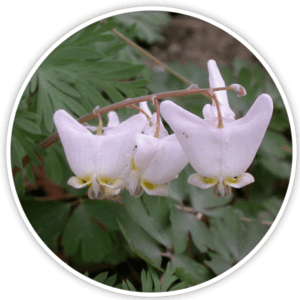 |
|
Spring Beauty (Claytonia virginica) These are the most widely distributed early spring flower in Missouri. White or pink with distinct pink veining on the petals. |
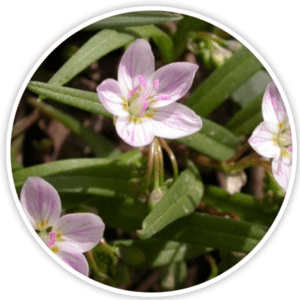 |
|
Blue-eyed Mary (Collinsia verna) The flowers of blue-eyed Mary are 2-lipped: the upper lip is 2-lobed and white; the lower lip is 3-lobed and sky blue (rarely purple or white). This is one of the few Missouri wildflowers that is truly “blue.” |
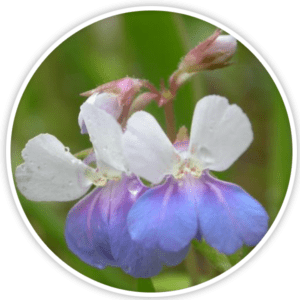 |
|
Wake Robin or Trillium (Trillium sessile) The flower of wake robin, or trillium, has 3 petals and 3 sepals, and 3 leaves that subtend the solitary flower. The petal color varies in this common woodland spring wildflower, but it is most commonly brownish or maroon. |
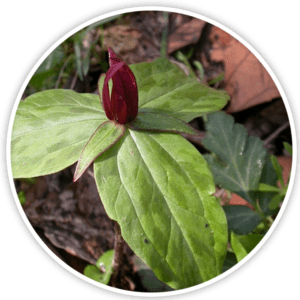 |
|
Jacob’s Ladder (Polemonium reptans) As pretty as this wildflower is, the common name “Jacob’s Ladder” comes from its leaves, which made people think of the story from Genesis in which Jacob dreams of a ladder reaching up to heaven. |
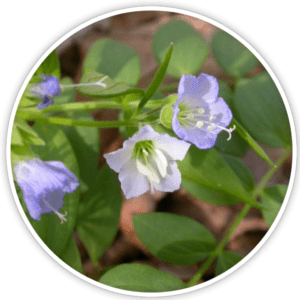 |
Best Greenways for Viewing Wildflowers
Some of the greenways provide better habitat than others for spring ephemerals and wildflowers. Those that meander through forests, across bottom land, or other conservation areas are your best bet for a colorful show. Take your pick of the following (or plan to visit them all this spring!):
Busch Greenway: Katy Trail to Missouri Research Park to August A. Busch Conservation Area
Where to look: There are two prime viewing spots along this greenway; the forest bottom between Missouri Research Park and the Katy Trail as well as the portion of the greenway that meanders through the Weldon Spring Conservation Area.
Mississippi Greenway at Cliff Cave Park
Where to look: In the spring, look for wildflowers along the paved trail in the lower section of the park. You might also find some along the paved trail in the area surrounding the entrance to the cave.
Missouri Greenway: Earth City Levee in Riverwoods Park
Where to look: Look for wildflowers in the southern part of the park along the greenway. ( Note that a portion of the greenway has been closed along the river due to repeated flood damage. You can still walk, bike or run on the rest of the greenway, but will need to turn around at the points of closure.)
Meramec Greenway: Glencoe to Sherman Beach Park
Where to look: The bottomland forest along Rock Hollow Trail is known for its showy display of bluebells. You can find all of the wildflowers listed above along this greenway.
Other places to enjoy native plants and wildflowers early this summer:
- Trojan Park on the St. Vincent Greenway in Wellston has a beautiful garden filled with native plants!
- Gravois Greenway: Grant’s Trail at Mysun Charitable Foundation Trailhead (by Orlando’s)
- River des Peres Greenway: Raingarden between Route 66 and Lansdowne
- Busch Greenway near roundabout connection to Hamburg Trail.
- Katherine Ward Burg Garden on Laclede’s Landing
Please Don’t Pick the Wildflowers!
Because these flowers are so beautiful, it can be tempting to want to pick them or dig them up for transplanting. Not only is this unsightly, it also removes an important food source for pollinators and other animals. Because the plant’s life cycle is so short, animals that might eat the foliage have only a brief opportunity to consume them. Enjoy the flowers, snap a picture, and leave them where they are! If you would like to add beautiful native flowers to your garden, you can find ethical plant nurseries and other resources here.
Wildflower photos and plant information are all courtesy of the Missouri Department of Conservation. To learn more about what plants and animals to look for during every season, visit their website here.
